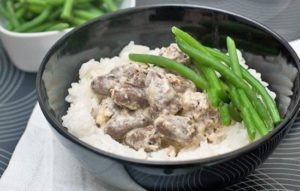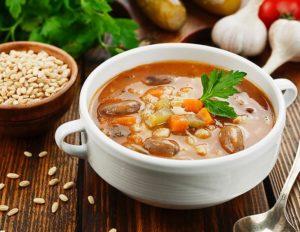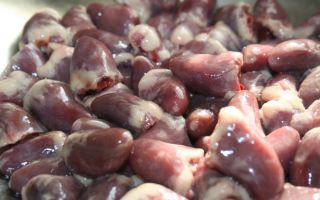Content
- 1 The chemical composition of the chicken heart
- 2 Nutritional value and calorie content of chicken hearts (per 100 g)
- 3 The benefits of a chicken heart for the body
- 4 Are chicken hearts good for weight loss?
- 5 Chicken hearts during pregnancy and breastfeeding
- 6 At what age can chicken hearts be given to children
- 7 Is it possible to eat chicken hearts with diabetes and pancreatitis
- 8 How to cook chicken hearts properly
- 9 What can be cooked from chicken hearts
- 10 Harm of chicken hearts and contraindications
- 11 How to choose and store chicken hearts
- 12 Conclusion
The heart is the smallest chicken by-product. Despite its weight of 30 grams, it has a high nutritional value to ensure healthy human life. The benefits and harms of chicken hearts are a topic of concern to many, which is associated with disputes about the nutritional value of the product and dangerous technologies for growing poultry. Let's take a closer look.

The chemical composition of the chicken heart
Chicken hearts are a very good source of protein (up to 21 g / 100 g), B vitamins (niacin, PP - up to 50% and riboflavin B2 - up to 60% of the recommended daily requirement - RDA), zinc and iron (25 and 31% RDA , respectively), as well as cobalt, copper and phosphorus (102, 31, and 22% of the RDI).
Thus, a small serving of chicken hearts can cover a person's daily need for these nutrients.
The chicken heart contains lysine, which improves the synthesis of enzymes and hormones, and, in addition, has a strong antiviral effect. Therefore, hearts are indicated for use during the rehabilitation period after viral infections and colds.
Nutritional value and calorie content of chicken hearts (per 100 g)
|
Treatment type |
Proteins / Fats / Carbohydrates (g) |
Calorie content (kcal) |
|
For a couple |
13,25/10,03/1,89 |
153,55 |
|
Boiled |
21,22/9,90/0,88 |
157,14 |
|
Stewed |
14,21/9,50/1,03 |
168,48 |
|
Fried |
13,49/10,41/2,07 |
184,53 |
The benefits of a chicken heart for the body
The combination of low calorie content - 160 calories per 100 grams - and high nutritional value plays a role in dietitian recommendations to include one meal of this product in the weekly diet.
Chicken hearts contain many vitamins and minerals that are beneficial to the human body.
So, Copper and Iron are involved in the production of endorphin and hemoglobin, maintain the elasticity of the fibers.
The high content of Cobalt in 100 g of chicken hearts, which covers the daily norm (120%), has important indications for anemia, diabetes and decreased immunity, since this trace element, together with iron and copper, helps to produce red blood cells in the bone marrow, stimulates cell regeneration, and besides Moreover, it takes part in protein synthesis and the transmission of hereditary information.
Zinc is a constituent of more than 300 enzymes, takes part in the synthesis and balance of proteins, fats, carbohydrates
Phosphorus is important for the mineralization of the body, the growth of bones and teeth, and is involved in the process of cell division and metabolism.
Magnesium contained in chicken hearts has a stabilizing effect on the cardiovascular and endocrine systems, has a beneficial effect on the properties of the brain, and also helps to remove toxic substances.
Potassium is involved in maintaining water balance, the required amount of salts, alkalis, acids, improves cardiac motility and brain activity, increasing the flow of oxygen received. It also reduces the risk of allergic reactions and reduces swelling.
Sodium in the by-product takes an active part in the normalization of blood pressure, heart rate, balance of water and salt in the body, so it is so necessary for digestion and the production of gastric juice.
Vitamin B2, riboflavin - is simply irreplaceable in the processes of growth, regulation of the central nervous system, vision, metabolism. It improves the condition of the skin and mucous membranes, providing the functions of the liver and blood formation.
Based on the nutritional value, hearts are prescribed in the following cases:
- anemia;
- hypertension;
- ischemic heart disease;
- diabetes mellitus;
- diets in old age.
Chicken heart also benefits men in strength sports as it serves as a natural animal protein essential for muscle growth and repair. So, the essential amino acid leucine promotes the growth of muscle fibers, and thanks to the contained leucine, the process of decomposition of substances and the associated removal of toxins is slowed down.
Are chicken hearts good for weight loss?
The amino acid methionine, contained in chicken hearts, is invaluable for diets, increasing the functionality of the liver and helping to quickly remove fats from the body.
Dishes with this product are distinguished by useful dietary and nutritional properties, especially if they are boiled over low heat or steamed: with such processing, their calorie content will be minimal, but the benefits will be maximum.
While in a fried and stewed product, the calorie figure will seriously increase, boiled hearts can be included 2 to 4 times a month when drawing up a diet.
Chicken hearts during pregnancy and breastfeeding
For young mothers and those who will soon become them, it is useful to take into account that such a product exists. The benefits of chicken hearts for pregnant women and women who have given birth are enormous due to the high risk of anemia associated with bearing a child. Pregnancy and lactation are characterized by an increased need for iron.
Micro- and macroelements, vitamins and amino acids contained in chicken hearts make them indicated and even irreplaceable participants in the growth of the baby's body.
At what age can chicken hearts be given to children
First, the child needs to be taught to different types of meat. Then, at the age of about 9 months, chicken hearts can be introduced as complementary foods. For this, it is more useful to use homogenized puree, it tends to be easier for the stomach to digest. You should start with half a teaspoon, gradually bringing it to 40-50 g. It is better to give such complementary foods in the morning, first observing the baby's condition.
Is it possible to eat chicken hearts with diabetes and pancreatitis
The essential amino acids found in chicken hearts have the ability to stabilize blood sugar. Therefore, they are good for people with a medical condition such as diabetes. Isoleucine in the composition of the product works to normalize blood glucose levels, increase hemoglobin, and valine balances the hormonal background and nervous processes in general.
Chicken hearts are easy to digest and have beneficial dietary properties, therefore, they are beneficial for people suffering from diseases of the gastrointestinal tract (GIT), especially when they are steamed.
With pancreatitis, chicken offal should be included in the diet with extreme caution. It is indicated for patients in the chronic stage and with prolonged remission.
In such cases, with health benefits, you can use chicken hearts, the properties of which become optimal due to boiling for 3 hours without adding spices.
How to cook chicken hearts properly
Chicken hearts, like any other delicacy, have their own cooking secrets. A hostess who does not know them can get a tough and unpleasant smelling dish. The reason for such troubles is the wrong technology of the preparation of the product by the manufacturer, for example, when bile gets into it. But you shouldn't despair: everything is fixable.
Since the heart is a circulatory organ, when preparing it for heat treatment, you need to make sure that there are no blood clots left in it. If there are any, they must first be removed. To do this, each heart is cut in the center and opened, like a book. After that, it is thoroughly cleaned of, possibly, caked blood remaining there, as well as of all protruding white blood vessels, veins and films. Then they are well washed and soaked in vinegar: 5 minutes is enough. This will help eliminate the bitterness from bile, if any.
It is customary to pre-cook chicken hearts to get rid of harmful microorganisms and possible antibiotic residues. This is done within an hour, while the first broth is drained.
To get a soft and juicy finished dish, you need to use the lid when cooking so that the steam constantly circulates through the pan, helping to maintain an optimally humid mode. When frying, do not keep chicken hearts in a pan for a long time: it will be enough in hot oil for up to a minute to get a light crust, and then add onions, carrots and other vegetables that will help them not lose juice.
You can get the most out of a dish prepared with steamed vegetables.
Another way to give a delicate structure to chicken hearts when cooking is to pre-beat them and cut them additionally or in half or quarters.
Whole, large chicken hearts need to be boiled for longer than 1 hour.
Hearts are stewed for about 30 minutes. By adding vegetables and sour cream to them, you can shorten the cooking time and add spicy properties to the dish.
What can be cooked from chicken hearts

A dish of chicken hearts turns out to be tender, satisfying and low in calories. They can be boiled, fried, stewed with various vegetables or cereals: everything will be fantastically delicious.
You can make a wide variety of treats from hearts:
- Soups with various ingredients.
- You can fry them as a separate dish, for example, skewers on skewers.
- Can be stewed with mushrooms, potatoes, eggplants.
- Or stew separately in sour cream or cream, and serve rice, buckwheat as a side dish, pasta.
Stewed chicken hearts in sour cream

Ingredients:
- chicken hearts - 500 g;
- sour cream - 2 tbsp;
- medium onion - 1 pc;
- medium carrots - 1 pc;
- leek 1 pc;
- olive oil;
- salt, pepper - to taste.
Cooking process:
- Thoroughly wash chicken hearts, clean them of blood vessels and fat.
- Cut the onion into half rings and send it to the pan with heated oil. Fry until golden brown.
- Put the hearts out and simmer for 10 minutes.
- Add carrots cut into small strips. Continue simmering for another 5 minutes. Season with salt and pepper.
- Sprinkle the finished dish with leeks, cut into rings.
Can be served with a side dish of rice, buckwheat.
Chicken heart soup

Ingredients:
- chicken hearts 200 g;
- medium potatoes 2 pcs;
- small onion 1 pc;
- small carrot 1 pc;
- tomato paste 1 tbsp;
- greens 1 bunch;
- salt, spices to taste.
Cooking process:
- Wash hearts, make an incision, get rid of fat and blood clots.
- Send the hearts to boiling water, boil for 10 minutes, then drain the broth.
- Add clean water and bring to a boil.
- Fry lightly onions and carrots, add a spoonful of tomato paste.
- Put frying and potatoes in a boiling broth, cook for 25 minutes.
- Add salt, spices and let it brew for about half an hour.
Sprinkle with herbs when serving.
Harm of chicken hearts and contraindications
The benefits and harms of chicken hearts for the human body are determined by various factors, including such as the use of hormones and antibiotics when raising chickens.
Hormones are used to increase the commercial benefit for raising chicken on a production scale. It is believed that adding them in moderation does not change the quality of the meat, and the health of chicken lovers does not suffer. However, the problem comes down to defining a safe norm, so the question remains open, especially since manufacturers usually hide the fact of adding hormones.
The topic of the officially permitted addition of penicillin antibiotics when growing poultry in order to prevent avian diseases is also relevant. Antibiotics can remain in poultry carcasses, which can harm the consumer's body if the permissible dose (20 g per ton of meat) is exceeded, or if there is an allergic reaction to penicillins.
Exceeding the recommended amount of chicken hearts can also cause harm due to cholesterol and saturated fat in their composition.
A healthy adult can eat chicken heart no more than 2 to 3 times a week.
Contraindications also include individual protein intolerance and gastrointestinal diseases, especially in the acute phase: when drawing up a dietary menu, consultation with a doctor is required.
How to choose and store chicken hearts
The healthy product is on sale chilled and frozen.
Preference should be given to chilled hearts, since during such storage all useful properties are optimally preserved in them.
In both cases, the first step is to inspect the packaging:
- it should be free of any damage;
- be marked with the time of manufacture and sale.

For a frozen product, the main criterion is the minimum amount of ice. Ideally, there should be a light ice frosting. A large amount of ice will indicate not in favor of the choice of the product, and mean that it has already been defrosted.
When choosing, you need to pay attention:
- for an even color of the product;
- lack of spots and a large number of blood vessels;
- for a dense and smooth texture;
- the optimal heart size is within 4 cm.
Conclusion
The benefits and harms of chicken hearts are important information necessary for the correct selection of the menu and depends on a number of factors.
The chicken heart serves as a storehouse of micro- and macroelements, essential amino acids for humans. At the same time, all the benefits of the delicacy can be reduced by combining with other foods containing a large amount of cholesterol and fat, while adding vegetables can create an optimal healthy composition. It is important to maintain the recommended consumption rate.
To neutralize the harm of the possible presence of antibiotics in the composition, it is necessary to properly heat the product.

